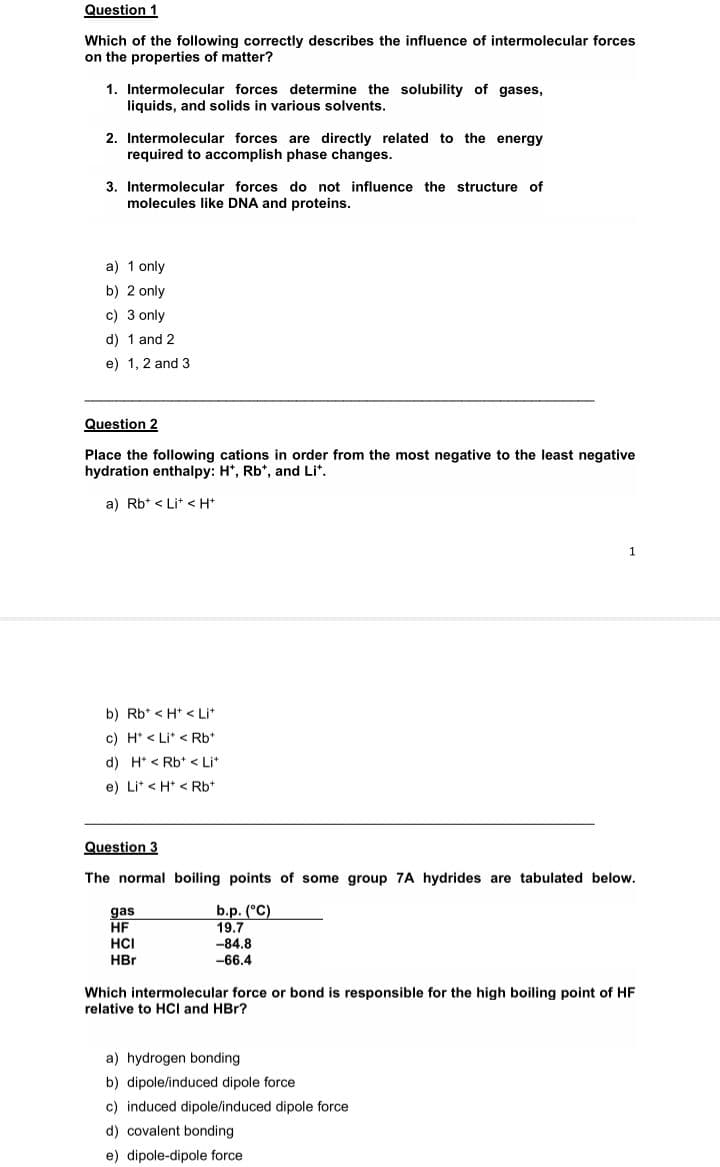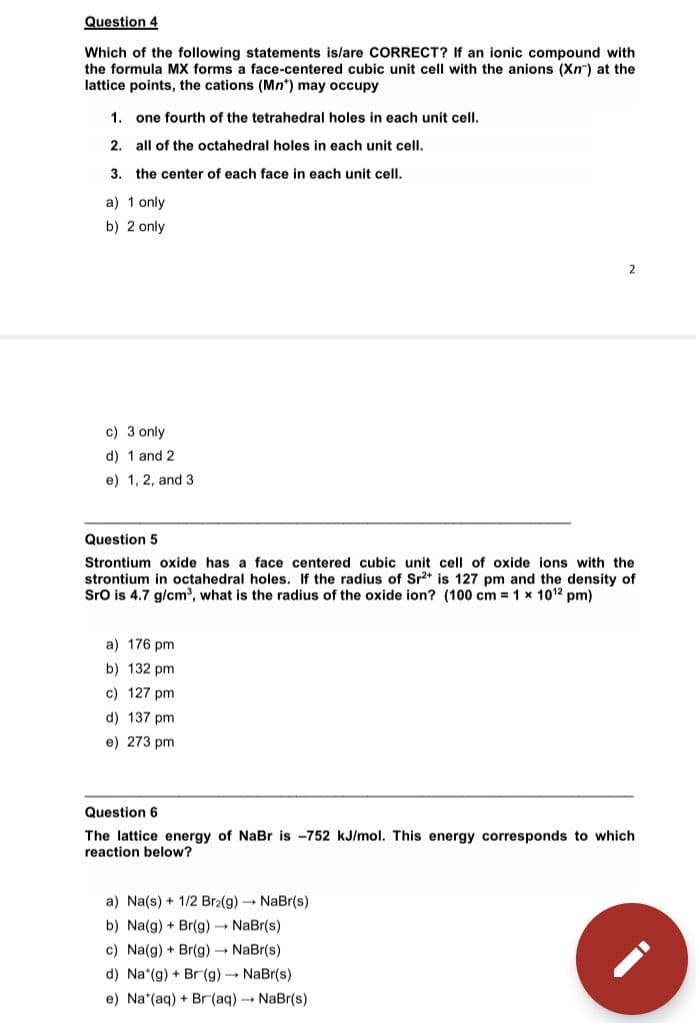Which of the following correctly describes the influence of intermolecular forces on the properties of matter? 1. Intermolecular forces determine the solubility of gases, liquids, and solids in various solvents. 2. Intermolecular forces are directly related to the energy required to accomplish phase changes. 3. Intermolecular forces do not influence the structure of molecules like DNA and proteins. a) 1 only b) 2 only c) 3 only d) 1 and 2 e) 1,2 and 3 Question 2 Place the following cations in order from the most negative to the least negative hydration enthalpy: H*, Rb*, and Li". a) Rb* < Lit < H*
Which of the following correctly describes the influence of intermolecular forces on the properties of matter? 1. Intermolecular forces determine the solubility of gases, liquids, and solids in various solvents. 2. Intermolecular forces are directly related to the energy required to accomplish phase changes. 3. Intermolecular forces do not influence the structure of molecules like DNA and proteins. a) 1 only b) 2 only c) 3 only d) 1 and 2 e) 1,2 and 3 Question 2 Place the following cations in order from the most negative to the least negative hydration enthalpy: H*, Rb*, and Li". a) Rb* < Lit < H*
Chapter10: Liquids And Solids
Section: Chapter Questions
Problem 1RQ: What are intermolecular forces? How do they differ from intramolecular forces? What are...
Related questions
Question

Transcribed Image Text:Question 1
Which of the following correctly describes the influence of intermolecular forces
on the properties of matter?
1. Intermolecular forces determine the solubility of gases,
liquids, and solids in various solvents.
2. Intermolecular forces are directly related to the energy
required to accomplish phase changes.
3. Intermolecular forces do not influence the structure of
molecules like DNA and proteins.
a) 1 only
b) 2 only
c) 3 only
d) 1 and 2
e) 1, 2 and 3
Question 2
Place the following cations in order from the most negative to the least negative
hydration enthalpy: H*, Rb*, and Li*.
a) Rb* < Lit < H*
b) Rb* < H* < Li*
c) H* < Li* < Rb*
d) H* < Rb* < Li*
e) Li* < H* < Rb*
Question 3
The normal boiling points of some group 7A hydrides are tabulated below.
gas
HF
HCI
b.p. (°C)
19.7
-84.8
HBr
-66.4
Which intermolecular force or bond is responsible for the high boiling point of HF
relative to HCI and HBr?
a) hydrogen bonding
b) dipole/induced dipole force
c) induced dipole/induced dipole force
d) covalent bonding
e) dipole-dipole force

Transcribed Image Text:Question 4
Which of the following statements is/are CORRECT? If an ionic compound with
the formula MX forms a face-centered cubic unit cell with the anions (Xn) at the
lattice points, the cations (Mn*) may occupy
1. one fourth of the tetrahedral holes in each unit cell.
2. all of the octahedral holes in each unit cell.
3. the center of each face in each unit cell.
a) 1 only
b) 2 only
2
c) 3 only
d) 1 and 2
e) 1, 2, and 3
Question 5
Strontium oxide has a face centered cubic unit cell of oxide ions with the
strontium in octahedral holes. If the radius of Sr2* is 127 pm and the density of
Sro is 4.7 g/cm', what is the radius of the oxide ion? (100 cm = 1 x 1012 pm)
a) 176 pm
b) 132 pm
c) 127 pm
d) 137 pm
e) 273 pm
Question 6
The lattice energy of NaBr is -752 kJ/mol. This energy corresponds to which
reaction below?
a) Na(s) + 1/2 Br2(g) NaBr(s)
b) Na(g) + Br(g) - NaBr(s)
c) Na(g) + Br(g) NaBr(s)
d) Na*(g) + Br(g) NaBr(s)
e) Na*(aq) + Br (aq) NaBr(s)
Expert Solution
This question has been solved!
Explore an expertly crafted, step-by-step solution for a thorough understanding of key concepts.
This is a popular solution!
Trending now
This is a popular solution!
Step by step
Solved in 2 steps

Knowledge Booster
Learn more about
Need a deep-dive on the concept behind this application? Look no further. Learn more about this topic, chemistry and related others by exploring similar questions and additional content below.Recommended textbooks for you


Chemistry: An Atoms First Approach
Chemistry
ISBN:
9781305079243
Author:
Steven S. Zumdahl, Susan A. Zumdahl
Publisher:
Cengage Learning

Chemistry
Chemistry
ISBN:
9781305957404
Author:
Steven S. Zumdahl, Susan A. Zumdahl, Donald J. DeCoste
Publisher:
Cengage Learning


Chemistry: An Atoms First Approach
Chemistry
ISBN:
9781305079243
Author:
Steven S. Zumdahl, Susan A. Zumdahl
Publisher:
Cengage Learning

Chemistry
Chemistry
ISBN:
9781305957404
Author:
Steven S. Zumdahl, Susan A. Zumdahl, Donald J. DeCoste
Publisher:
Cengage Learning

General Chemistry - Standalone book (MindTap Cour…
Chemistry
ISBN:
9781305580343
Author:
Steven D. Gammon, Ebbing, Darrell Ebbing, Steven D., Darrell; Gammon, Darrell Ebbing; Steven D. Gammon, Darrell D.; Gammon, Ebbing; Steven D. Gammon; Darrell
Publisher:
Cengage Learning

Chemistry for Engineering Students
Chemistry
ISBN:
9781337398909
Author:
Lawrence S. Brown, Tom Holme
Publisher:
Cengage Learning

Introductory Chemistry: An Active Learning Approa…
Chemistry
ISBN:
9781305079250
Author:
Mark S. Cracolice, Ed Peters
Publisher:
Cengage Learning